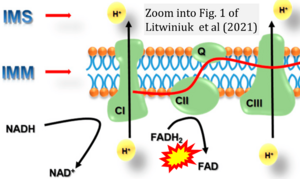Litwiniuk 2021 Pharmaceuticals (Basel)
| Litwiniuk A, Baranowska-Bik A, Domańska A, Kalisz M, Bik W (2021) Contribution of mitochondrial dysfunction combined with NLRP3 inflammasome activation in selected neurodegenerative diseases. Pharmaceuticals (Basel) 14:1221. https://doi.org/10.3390/ph14121221 |
Litwiniuk A, Baranowska-Bik A, Domanska A, Kalisz M, Bik W (2021) Pharmaceuticals (Basel)
Abstract: Alzheimer's disease and Parkinson's disease are the most common forms of neurodegenerative illnesses. It has been widely accepted that neuroinflammation is the key pathogenic mechanism in neurodegeneration. Both mitochondrial dysfunction and enhanced NLRP3 (nucleotide-binding oligomerization domain (NOD)-like receptor protein 3) inflammasome complex activity have a crucial role in inducing and sustaining neuroinflammation. In addition, mitochondrial-related inflammatory factors could drive the formation of inflammasome complexes, which are responsible for the activation, maturation, and release of pro-inflammatory cytokines, including interleukin-1β (IL-1β) and interleukin-18 (IL-18). The present review includes a broadened approach to the role of mitochondrial dysfunction resulting in abnormal NLRP3 activation in selected neurodegenerative diseases. Moreover, we also discuss the potential mitochondria-focused treatments that could influence the NLRP3 complex.
• Bioblast editor: Gnaiger E
Correction: FADH2 and Complex II
- FADH2 is shown as the substrate feeding electrons into Complex II (CII). This is wrong and requires correction - for details see Gnaiger (2024).
- Gnaiger E (2024) Complex II ambiguities ― FADH2 in the electron transfer system. J Biol Chem 300:105470. https://doi.org/10.1016/j.jbc.2023.105470 - »Bioblast link«


